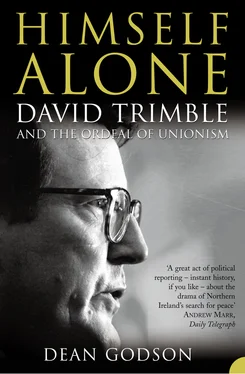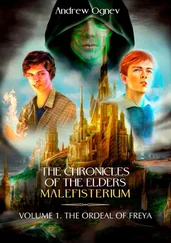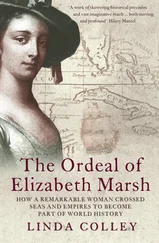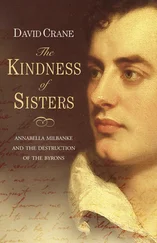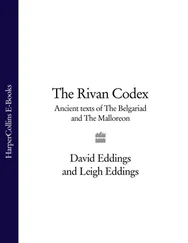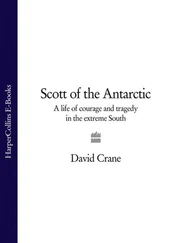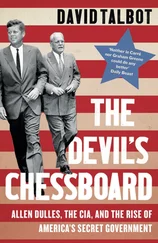A simpler explanation is that times of upheaval bring improbable individuals to the fore. After 1968, the state of Northern Ireland was under relentless assault. The offensive came first from the Civil Rights movement, elements of which successfully portrayed Stormont as little more than a discriminatory instrument of Protestant hegemony, and then from the resurgent IRA. Protestants, feeling their position under threat, retaliated. The exhausted RUC could not cope and regular British troops were dispatched during 1969 to aid the civil power. Three provincial Prime Ministers – Terence O’Neill, James Chichester-Clark and Brian Faulkner – resigned or were deposed in quick succession. Worse still from a Unionist viewpoint, many of the nationalist allegations of sectarian injustices and a repressive security system now found a sympathetic hearing in British official and journalistic circles. As long as Stormont ‘worked’ (in the sense of keeping things quiet) the British were happy enough to let it be. Once it was seen as a source of discontent and international embarrassment, the British cast around for less bothersome alternatives. The allegations against Stormont shaped one of the constants of British Government policy over a quarter-century: namely, that Unionists could never again be trusted with simple majority rule on the basis of the first-past-the-post electoral system. Henceforward, they would have to share power with representatives of the nationalist minority.
To a young man like Trimble, it all had a ‘disorienting effect. The established landmarks in one’s life were shifting and I did not know where it would lead to.’ 6 Trimble also disliked the way in which the British Army, which was accountable to central government, was introduced on to the streets of Northern Ireland in 1969. Like so many Loyalists, he felt it undermined the role of the old RUC and the locally raised militia called the Ulster Special Constabulary (or ‘B’ Specials), which were accountable to the Government of Northern Ireland. 7 He did not, however, initially respond by becoming politically active. Indeed, his first experience of elections owed more to informal peer pressure within the Law Faculty than to any reaction to the collapse of public order. Trimble was approached by Harry Calvert: would he help his friend Basil McIvor, then running in the 1969 Northern Ireland General Election as the Ulster Unionist candidate for one of the newly created south Belfast constituencies? Trimble knew McIvor’s wife Jill, who worked in the Law Faculty. ‘Even at that time I had difficulty in saying no,’ recalls Trimble. ‘I find it embarrassing. If people are pressing me, it’s easy to say no, but if they ask nicely, it’s much harder.’ 8
It was, at first glance, an unlikely pairing, for Basil McIvor was the most liberal of Unionists and a staunch ally of Terence O’Neill, Northern Ireland’s aloof, patrician Prime Minister. 9 Moreover, he was one of very few UUP MPs elected to the old Stormont not to have been a member of the Orange Order. 10 Trimble, by contrast, had always disliked O’Neill’s style and his increasingly flaccid response to the disturbances: he less minded O’Neill’s reforms than their timing, which he felt showed weakness and which could only encourage more violence. There was, however, another attraction in aiding McIvor. McIvor’s seat not only contained such unionist terrain as Larkfield, Finaghy and Dunmurry, but also included the adjacent, predominantly Catholic, area of Andersonstown: Trimble wanted to see what it was like and duly canvassed it. In February 1969, things were not yet so polarised as to preclude such an excursion and Trimble even received a good reception – so much so that he reckons that as many as 1000 to 1500 votes out of McIvor’s winning total came from Andersonstown (though some of these may have been cast by Protestants then still living in the area). 11
Subsequently, Trimble sought to join the UUP but received no reply to his letter of application. The inertia of party HQ at Glengall Street in central Belfast seemed to him to incarnate all that was wrong with the organisation of the time. Glengall Street had failed to provide a sustained or coherent intellectual response to the critique of the Northern Irish state advanced by the nationalists and their left-wing allies on the mainland. 12 In consequence, says Trimble, ‘quite a few contemporaries tamely accepted this fashionable view of things – of a politically and morally corrupt establishment. There was a widespread view then of a poor, down-trodden minority. Those of the same age as me all went with the spirit of the times – Unionist Government bad, Civil Rights movement good. When things went pear-shaped, one gets the impression that the middle classes opted out of unionist politics altogether and headed for a safe port. They found it in the nice, uncontroversial New Ulster Movement and later in the Alliance party’. The reaction of one colleague from Queen’s was typical of the times: driving down the Shankill Road past Malvern Street, where an organisation styling itself as the ‘UVF’ had perpetrated a couple of grisly murders in 1966, his companion observed ‘ah, we’re passing your spiritual home’. Trimble was angered by the remark, but was not deterred. Indeed, the challenge of articulating a Unionist response also appealed to the counter-cyclical, even contrarian aspects of his nature: ‘My feeling that they were wrong was not entirely intellectual, it was in my bones as well. But it took me a couple of years to work things out. I usually do find myself uncomfortable with fashionable views and I have spent most of my life arguing against them.’ 13
Trimble, therefore, responded to the crisis in the only way he knew: he searched the stacks at Queen’s and read, read and read. There was a dearth of material. For although there had been some ‘Unionist’ historical writing during the Stormont years – such as St John Ervine’s biography of Sir James Craig, the first Prime Minister of Northern Ireland – there had been little Unionist political thought since the 1950s. 14 With their massive majorities at Stormont, and little opposition, Ulster Unionists had become complacent. Trimble’s aim over the last 30 years, and especially since becoming leader, has been two-fold: first, to persuade Unionists to think politically and not just to wave the Union flag at election time; and, as a consequence of that, to persuade the broad unionist middle classes to re-engage in politics. Later, Trimble found one unexpected source of inspiration. These were the publications of the British and Irish Communist Organisation (first known as the Irish Communist Organisation). Many then considered B&ICO was then a self-consciously Stalinist (but non-sectarian) faction. A substantial number of its leading lights believed that the British multi-national state was invested with certain progressive possibilities (by contrast, a large number of them contended that northern nationalism, encouraged by southern irredentist elements, was a sectional diversion from the reality of class struggle). Adapting Stalin’s theory of nationality to the Irish context, B&ICO had come to conclude that Irish republicans had fundamentally misanalysed the situation. Far from northern Protestants being a minority within the Irish nation, they were a distinct nation of their own, no less entitled than the Catholics to political self-determination: any attempt to coerce them would not merely be foredoomed to failure, but would also lead to a blood-bath by virtue of dividing the working class. This became known as the ‘two nations’ theory (at the same time, B&ICO also believed in civil rights for Catholics – and that the British state was the best vehicle for achieving these complementary ends). He was particularly influenced by three of their pamphlets: The Economics of Partition, The Birth of Ulster Unionism and The Home Rule Crisis 1912–14. In time, Trimble also became a fan of Workers’ Weekly , the newsletter of an allied organisation, the Workers’ Association for a Democratic Settlement of the National Conflict in Ireland – a compliment which that journal did not always reciprocate through the late 1970s and 1980s. It found him too devolutionist and Ulster nationalist for their more integrationist tastes (in its issue of 28 October 1978, following Trimble’s speech at the UUP conference, Workers’ Weekly described him as an ‘advocate of getting Stormont back at all costs’). After Trimble became leader, the links with the left endured. Thus, Paul Bew, Professor of Irish Politics at Queen’s and Henry Patterson, Professor of Politics at the University of Ulster – both of them formerly of the Workers’ Association – became two of his strongest supporters in academe. And John Lloyd, the staunchly Trimbleista former Editor of the New Statesman who later worked for the Financial Times , had been in B&ICO itself for a time.
Читать дальше
